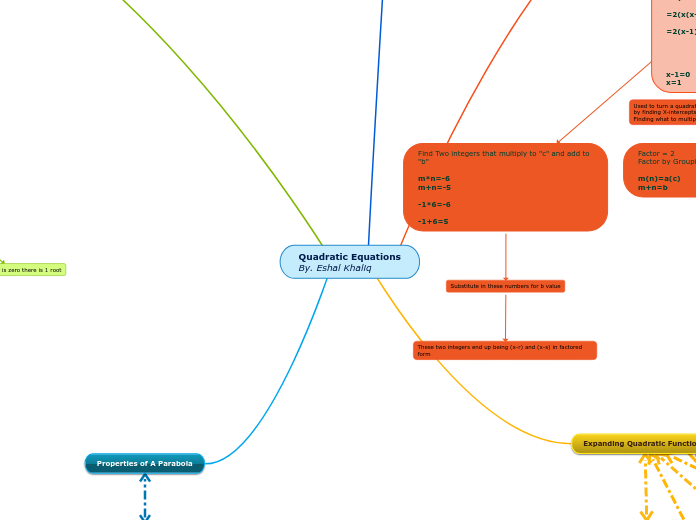Quadratics Functions
Parts of Parabolas
and Definitions
Zeros/Roots
---------------
When the parabola
crosses the x-axis,
the x-coordinate it is
called zeros or the
x-intercept.
Axis of Symmetry (AOS)
----------------------------
A vertical line that depicts
the point of symmetry
Vertex
---------------------
A parabola
has a minimum
(opens upward)
& maximum (opens
downward) value.
It is also the point
of AOS.
Optimal Value
----------------
The y-value of
the vertex.
Y-Intercept
--------------
The coordinate
where the parabola
crosses the y-axis.
Solving Quadratic
Equations
Using Quadratic
Formula
Discriminant
-------------
b^2 - 4ac
1) If the discriminant is
greater than 0, then there
are 2 real roots
2)If the discriminant is
equal to 0, then there
is 1 real root.
3) If the discriminant is
than 0, then there are
no real roots.
Use this formula
when you cannot
factor.
Complete the
Square
Convert Standard Form
into Vertex Form and
use this to find min./max.
value or vertex of parabola.
1) Start by factoring out the a
2) Move the c term to the other side of the equation.
3) Use the b term in order to find a new c term that makes a perfect square. This is done by first dividing the b term by 2 and squaring the quotient and add to both sides of the equation.
4) Find your h, the b term divided by two, for the perfect square.
5) Set equation to zero.
x^2+2x-8=0
(x+1)^2 - (1)^2 - 8 =0
(x+1)^2-1-8=0
(x+1)^2-9=0
(x+1)^2=9
x+1=+- (square root of 9)
x=-3-1 x=3-1
x=-4 x=2
Expanding
FOIL Method
---------------
First Outer
Inner Last
(x+5)(x+2)
=x^2+2x+5x+10
=x^2+7x+10
Factor
Difference of Squares
--------------------------
(a+b)(a-b)
= a^2 - b^2
(9x^2-16)
=(3x)^2 - 4^2
= (3x+4)(3x-4)
Perfect Square
Trinomial
-----------------------
(a+b)^2
= a^2 + 2ab + b^2
(a-b)^2
= a^2 - 2ab - b^2
(3x+2y)^2
=3^2 + 2(3)(2) + (2)^2
= 9x^2+12xy+4y^2
Complex Trinomial
Simple Trinomial
Find 2 numbers that
multiply to c and add
to b.
1) Use Criss-Cross Method
2) MAN Method
(Multiply, Add, Number)
x^2-2x-15
M- -15
A- -2
N- (-5,3)
=(x-5)(x+3)
Common Factor
Factor by Grouping
-----------------------
1) group terms with
like terms
2)factor each group to
get a binomial common
factor
3x^2+6x+4x+8
=(3x^2+6x)+(4x+8)
= 3x(x+2)+4(x+2)
= (3x+4)(x+2)
Find the GCF and take
it out by dividing each
term by the GCF.
6x^2 - 2x = 0
2x(3x-1)=0
2x=0 3x-1=0
x=0 x=1/3
Forms of
Quadratic Equations
Factored Form:
y=a(x-r)(x-s)
To find the x-value
of the vertex, use the
formula (r+s)/2
Binomials (x-r) and
(x-s) gives the x -
intercepts.
y= 0.5(x-6)(x+2)
--------------------
(x-6)= 0 (x+2)=0
x=0+6 x=0-2
x= 6 x= -2
Standard Form:
y=ax^2+bx+c
A rock is thrown from the top of a tall building. The distance, in feet, between the rock and the ground t seconds after it is thrown is given by d(t) = -16t^2 – 4t + 382. How long after the rock is thrown is it 370 feet from the ground?
---------------------------------------------------
d(t) = 16t^2 - 4t +382
-16t^2 - 4t + 382 = 370
-16t^2 - 4t + 382 - 370 = 0
-16t^2 - 4t + 12 = 0
16t^2 + 4t - 12 = 0
4t^2 + t - 3 = 0
(4t - 3)(t + 1) = 0
4t - 3 = 0 or t + 1 = 0
t = 3/4 or t = -1
Therefore, it takes 75 seconds to reach 370 feet.
a,b, and c are real
numbers and a is
not equal to 0
Formula for AOS
x = -b/2a
a is the stretch/
compression factor
Step Pattern
---------------------
Multiply a value
and step pattern
to get the correct
points of the
parabola
(1,3,5) * a
Transformation of Parabola
--------------------------------
If a>1 then the graph is
stretching vertically by a
value. If 0
Direction of Opening
-------------------------
If a>0 it is opening
upwards. If a<0 it is
opening downwards.
c value is the
y-intercept
of the parabola
Vertex Form:
y=a(x-h)^2+k
Ming throws a stone off a bridge into a river below. The stone's height (in meters above the water), x seconds after Ming threw it, it is modeled by:
h(x)=-5(x-1)^2+45
What is the maximum height that the stone will reach?
The maximum height is reached at the vertex. So, in order to find the maximum height, we need to find the vertex's y-coordinate. The vertex is (1, 45). So, in conclusion, the stone reaches the maximum height at 45 meters.
Transformation
--------------------------
y= (x - h)^2, then the
parabola is shifted
right by h units.
y= (x+ h)^2, then the
parabola is shifted left
by h units
y= x^2 - k, then the
parabola is shifted
down by k units.
y= x^2 + k, then the
parabola is shifted up
by k units.
Vertex/Axis Of Symmetry (AOS)
= (h,k)
k is the y value of
vertex and AOS
If k>0 is a vertical
shift up by k units.
If k<0 is a vertical
shift down by k units.
h is the x value of
vertex and AOS
If h>0 is a horizontal
shift to the right. If
h<0 is a horizontal
shift to the left.









